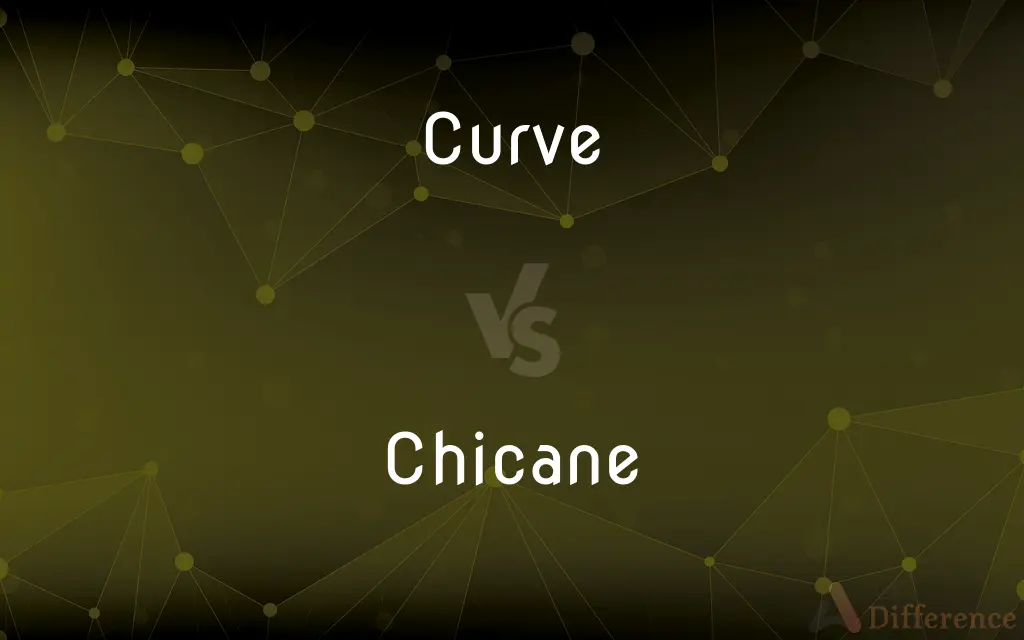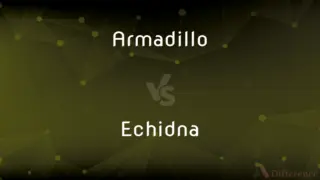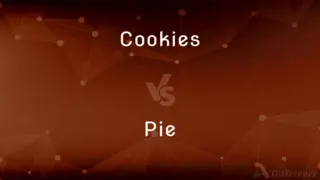Curve vs. Chicane — What's the Difference?
Edited by Tayyaba Rehman — By Urooj Arif — Updated on April 15, 2024
A curve is a continuous and smooth bending line without angles, commonly seen in roads or designs; a chicane is a series of tight turns in alternating directions on a racetrack designed to reduce speed.

Difference Between Curve and Chicane
Table of Contents
ADVERTISEMENT
Key Differences
A curve refers to any bending line or geometric figure without angles or interruptions, often used to describe smooth turns in roads or paths. In contrast, a chicane involves a deliberate design of alternating tight turns, specifically in motorsport tracks to add challenge and reduce speed.
In road design, curves are implemented to naturally follow the landscape or to connect segments of a roadway in a flowing manner, enhancing the driving experience while maintaining a steady traffic flow. Whereas chicanes are added to racing circuits and sometimes on public roads to specifically slow down vehicles, increase driver skill demand, and improve safety.
Curves are often characterized by their radius and degree, which define their sharpness and the angle through which the direction changes. On the other hand, chicanes are characterized not only by these features but also by the sequence and severity of the turns they incorporate.
In terms of driving, navigating through a curve typically requires moderate adjustment of speed and steering depending on the curve’s radius. Conversely, chicanes require precise control of braking, acceleration, and steering to handle the abrupt changes in direction.
Aesthetically, curves offer a visually pleasing element in both architecture and nature by providing a sense of continuity and flow. Chicanes, however, are more about functionality and safety in motorsports, creating strategic challenges for racers.
ADVERTISEMENT
Comparison Chart
Definition
A smooth, continuous bend in a line or road.
A series of tight turns in alternating directions designed to slow speed.
Purpose
To connect two points in a flowing manner.
To reduce speed and increase driving challenge.
Commonly found
Roads, designs, nature.
Race tracks, some traffic-calming areas.
Navigation
Requires moderate speed and steering adjustments.
Demands precise control of speed, braking, and steering.
Aesthetic Appeal
Enhances visual continuity and flow.
Focuses on functionality and safety, less on aesthetics.
Compare with Definitions
Curve
A line or surface that deviates from being straight without angles.
The river followed a natural curve through the forest.
Chicane
A series of sharp turns in opposite directions on a racetrack.
The driver skillfully maneuvered through the chicane without losing speed.
Curve
A graphic representation of varying quantities, such as a growth curve.
The population growth curve shows a significant increase over the decades.
Chicane
Occasionally used in road safety designs to manage traffic speeds.
The urban planners implemented a chicane to reduce accidents at the intersection.
Curve
A bend in a road or path.
Drivers must slow down when approaching a sharp curve.
Chicane
Refers specifically to the layout or the architectural feature in racetracks or roads.
Spectators often gather at the chicane to watch the thrilling maneuvers of drivers.
Curve
In mathematics, a one-dimensional continuum with no breaks.
The parabola is a common type of mathematical curve.
Chicane
An artificial feature added to a road to slow traffic.
The new chicane has successfully calmed traffic in our residential area.
Curve
In sports, a curveball; a type of pitch in baseball with a pronounced trajectory.
The pitcher threw an impressive curve that baffled the batter.
Chicane
Used in motorsports to enhance the technical difficulty of a track.
Adding a chicane to the track increased the overall challenge for racers.
Curve
In mathematics, a curve (also called a curved line in older texts) is an object similar to a line, but that does not have to be straight. Intuitively, a curve may be thought of as the trace left by a moving point.
Chicane
A chicane () is a serpentine curve in a road, added by design rather than dictated by geography. Chicanes add extra turns and are used both in motor racing and on roads and streets to slow traffic for safety.
Curve
A line that deviates from straightness in a smooth, continuous fashion.
Chicane
To resort to tricks or subterfuges; use chicanery.
Curve
A surface that deviates from planarity in a smooth, continuous fashion.
Chicane
To trick; deceive.
Curve
Something characterized by such a line or surface, especially a rounded line or contour of the human body.
Chicane
Chicanery.
Curve
A relatively smooth bend in a road or other course.
Chicane
(Games) A bridge or whist hand without trumps.
Curve
A line representing data on a graph.
Chicane
A quibble, a pedantic or dishonest objection; an act of deception.
Curve
A trend derived from or as if from such a graph
"Once again, the politicians are behind the curve" (Ted Kennedy).
Chicane
The use of dishonest means or subterfuge to achieve one's (especially political) goals; chicanery, trickery.
Curve
A graphic representation showing the relative performance of individuals as measured against each other, used especially as a method of grading students in which the assignment of grades is based on predetermined proportions of students.
Chicane
The holding of a hand without trumps, or the hand itself.
Curve
The graph of a function on a coordinate plane.
Chicane
(motor racing) A sharp double bend on a racecourse, designed to prevent unsafe speeds; an obstacle creating a curve.
Curve
The intersection of two surfaces in three dimensions.
Chicane
A raised area or other obstacle around which vehicles must drive, especially designed to reduce speed.
Curve
The graph of the solutions to any equation of two variables.
Chicane
(intransitive) To use chicanery, tricks, or subterfuge.
Curve
(Baseball) A curve ball.
Chicane
(transitive) To deceive.
Curve
(Slang) Something that is unexpected or designed to trick or deceive.
Chicane
The use of artful subterfuge, designed to draw away attention from the merits of a case or question; - specifically applied to legal proceedings; trickery; chicanery; caviling; sophistry.
To shuffle from them by chicane.
To cut short this chicane, I propound it fairly to your own conscience.
Curve
To move in or take the shape of a curve
The path curves around the lake.
Chicane
In bridge, the holding of a hand without trumps, or the hand itself. It counts as simple honors.
Curve
To cause to curve.
Chicane
To use shifts, cavils, or artifices.
Curve
(Baseball) To pitch (a ball) with a curve.
Chicane
A bridge hand that is void of trumps
Curve
To grade (students, for example) on a curve.
Chicane
A movable barrier used in motor racing; sometimes place before a dangerous corner to reduce speed as cars pass in single file
Curve
(obsolete) Bent without angles; crooked; curved. Category:en:Curves
A curve line
A curve surface
Chicane
The use of tricks to deceive someone (usually to extract money from them)
Curve
A gentle bend, such as in a road.
You should slow down when approaching a curve.
Chicane
Defeat someone in an expectation through trickery or deceit
Curve
A simple figure containing no straight portions and no angles; a curved line.
She scribbled a curve on the paper.
Chicane
Raise trivial objections
Curve
A grading system based on the scale of performance of a group used to normalize a right-skewed grade distribution (with more lower scores) into a bell curve, so that more can receive higher grades, regardless of their actual knowledge of the subject.
The teacher was nice and graded the test on a curve.
Curve
(analytic geometry) A continuous map from a one-dimensional space to a multidimensional space.
Curve
(geometry) A one-dimensional figure of non-zero length; the graph of a continuous map from a one-dimensional space.
Curve
(algebraic geometry) An algebraic curve; a polynomial relation of the planar coordinates.
Curve
(topology) A one-dimensional continuum.
Curve
The attractive shape of a woman's body.
Curve
(transitive) To bend; to crook.
To curve a line
To curve a pipe
Curve
(transitive) To cause to swerve from a straight course.
To curve a ball in pitching it
Curve
(intransitive) To bend or turn gradually from a given direction.
The road curves to the right
Curve
(transitive) To grade on a curve (bell curve of a normal distribution).
The teacher will curve the test.
Curve
(transitive) (slang) To reject, to turn down romantic advances.
I was once curved three times by the same woman.
Curve
Bent without angles; crooked; curved; as, a curve line; a curve surface.
Curve
A bending without angles; that which is bent; a flexure; as, a curve in a railway or canal.
Curve
A line described according to some low, and having no finite portion of it a straight line.
Curve
To bend; to crook; as, to curve a line; to curve a pipe; to cause to swerve from a straight course; as, to curve a ball in pitching it.
Curve
To bend or turn gradually from a given direction; as, the road curves to the right.
Curve
The trace of a point whose direction of motion changes
Curve
A line on a graph representing data
Curve
A baseball thrown with spin so that its path curves as it approach the batter
Curve
The property possessed by the curving of a line or surface
Curve
Curved segment (of a road or river or railroad track etc.)
Curve
Turn sharply; change direction abruptly;
The car cut to the left at the intersection
The motorbike veered to the right
Curve
Extend in curves and turns;
The road winds around the lake
Curve
Form an arch or curve;
Her back arches
Her hips curve nicely
Curve
Bend or cause to bend;
He crooked his index finger
The road curved sharply
Curve
Form a curl, curve, or kink;
The cigar smoke curled up at the ceiling
Common Curiosities
How does a chicane affect the speed of vehicles?
It significantly reduces the speed by forcing drivers to navigate tight and alternating turns.
Can curves be found in areas other than roads or paths?
Yes, curves are prevalent in architecture, nature, and various forms of design.
Why are chicanes specifically used in race tracks?
To increase the difficulty and strategic elements of the track, enhancing the racing challenge.
How do you measure the sharpness of a curve?
By its radius and the degree of the angle through which the direction changes.
Are there safety considerations unique to chicanes?
Yes, chicanes must be designed to ensure they safely slow traffic without causing accidents due to sudden direction changes.
What is the primary purpose of a curve in road design?
To allow roads to follow the natural landscape and connect segments smoothly.
What are the visual impacts of curves and chicanes?
Curves enhance visual continuity and aesthetic flow, while chicanes focus more on functionality.
What skills are necessary to navigate a chicane effectively?
Precise control over braking, acceleration, and steering is crucial.
Can chicanes be added to existing roads?
Yes, chicanes can be retrofitted into existing roads to slow traffic or enhance safety.
Are chicanes used in everyday public road systems?
Yes, though less commonly than on racetracks, they are used to calm traffic and improve safety in certain areas.
Can the design principles of chicanes apply to pedestrian pathways?
Yes, similar principles can be applied to control pedestrian flow and enhance safety in crowded areas.
How do curves affect the speed of vehicles compared to chicanes?
Curves might require slight speed adjustments, while chicanes typically necessitate significant speed reduction.
What is the typical reaction of drivers to newly installed chicanes?
Drivers may initially react with caution and slower speeds as they adapt to the new road layout.
What distinguishes a chicane from a regular turn in a road?
Chicanes involve a series of sharp, alternating turns designed to slow down traffic, unlike regular turns which may simply follow the road’s natural route.
Is there a difference in how curves and chicanes are designed in terms of angle and sequence?
Yes, curves are generally smoother and less abrupt, while chicanes consist of deliberately sharp and alternating turns.
Share Your Discovery

Previous Comparison
Armadillo vs. Echidna
Next Comparison
Cookies vs. PieAuthor Spotlight
Written by
Urooj ArifUrooj is a skilled content writer at Ask Difference, known for her exceptional ability to simplify complex topics into engaging and informative content. With a passion for research and a flair for clear, concise writing, she consistently delivers articles that resonate with our diverse audience.
Edited by
Tayyaba RehmanTayyaba Rehman is a distinguished writer, currently serving as a primary contributor to askdifference.com. As a researcher in semantics and etymology, Tayyaba's passion for the complexity of languages and their distinctions has found a perfect home on the platform. Tayyaba delves into the intricacies of language, distinguishing between commonly confused words and phrases, thereby providing clarity for readers worldwide.














































